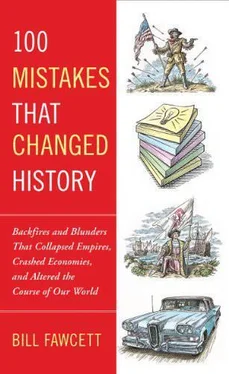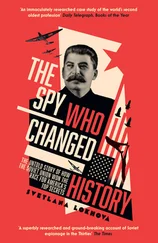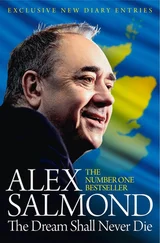33. SOME MISTAKES HAVE TURNED OUT WELL
A Math Error
1492
In 1491, a noted Spanish ship’s captain and seaman made a math error when calculating the circumference of the earth. At the equator, a line drawn all the way around our planet is about 25,000 miles long. This has been known and verified by various forms of mathematics since the time of ancient Egypt. But Christopher Columbus was convinced based on his own calculations that this number was 15,000 miles. That is a 10,000-mile difference and the reason he was sure he could reach China by sailing westward from Spain. If he had been correct, it would have been an easy sail. The error appears to have come from Columbus using the wrong value for a degree of longitude when looking at Chinese maps. It is even possible he used the distances as shown on Ptolemy’s maps, which were also far off.
At this time, the rivalry between Portugal, who had a painfully long but known route to the Orient around Africa, and Spain was intense. The Spanish monarchs were willing to do just about anything to find their own entry into the incredibly profitable trade. Many of us have heard the tale of Columbus convincing Queen Isabella that the earth was round by using an orange. There is no chance that really happened as just about every educated person in Europe already knew it was round. Columbus’ math error explains why the advisers to Ferdinand and Isabella all opposed financing his expedition. It wasn’t because they thought the earth was flat; it was because they had checked the sailor’s calculations. The learned men of Spain’s greatest court opposed financing the explorer because they had determined his math was wrong… and it was.
Even so, the Spanish monarchs decided to take a chance and in 1492 supplied three rather small ships to the mathematically challenged seaman. Or maybe it seemed a cheap way to just get rid of him after he had lobbied them for months on end. And so the rest is, as we say, history. Columbus sailed in the Nina , Pinta , and Santa Maria . Eventually, and rather heroically, he discovered the New World. Or at least he found a few islands in the Caribbean. The real importance of this being that Columbus showed everyone that something was there.
Incidentally, Columbus made another mistake while on his journeys. But this one was more fun. He mistook manatees for mermaids and recorded the finned women’s presence in the newly found waters.
Believing his own math was vindicated, the captain called the native peoples “Indians” and called the islands he finally landed on the “Indies.” Columbus died poor and would be amazed at how he has been revered today. He also might be a little upset to find out just how wrong he was. This math error may have been for Spain and Europe the most serendipitous mistake of all time. It brought the Spanish crown two centuries of plundered wealth and power while opening two continents to Europe.
Oh Yeah, and a New Continent
1500
The Portuguese spice trade route to the Orient was the glory and the secret of that small nation. They had found a path, albeit a long one, that bypassed the Islamic merchants. The route they took was to sail around Africa and then up the eastern African coast before sailing across to India. Navigation was primitive, and techniques for preserving food were not much better. Spending any time in the open waters could get a ship lost and doom the crew to a death of thirst or starvation. Most merchants in the fifteenth century tried to always stay in sight of land. The long trip was risky, but immensely profitable. If one ship in ten returned full of spices, the profits were enough to cover the cost of the lost ships and give the investors 1000 percent return on their money.
In 1500, a Portuguese merchant named Pedro Alvares Cabral led his own fleet of fifteen ships attempting to trace the route of Vasco da Gama to India. But rounding the horn of West Africa, his ships caught some unusual winds and were pushed away from the coast. This likely caused everyone on board a good deal of concern. He sailed south and ran into an unfamiliar coastline. Cabral knew it was not part of Africa because it was on the wrong side of the ocean. It was to his west, and since he was supposed to be sailing down the coast of Africa, that would be to his east. It was a strange and wild land covered mostly by jungle. Today we call the country he found Brazil. Cabral had other business: He was after spices, not new continents. So after sailing along its coast for ten days and claiming the new land in the name of his king, Manuel I, (more or less standard procedure in his time), the Portuguese admiral wrote up a report and sailed east until he found a coast that was on the correct side of the ocean. Cabral finally did reach India, and four of his ships made it back to Portugal more than a year later.
Four ships filled with spices made Cabral, his investors, and the crown very happily rich. He filed his report with the king of the new land he had claimed for him and nobody cared. Cabral had not seen any golden cities or diamond mines, so it took an amazing twenty-five years before anyone sailed to Brazil again. In the centuries that followed, the riches of Brazil made tiny Portugal a wealthy and prosperous nation. When a pope later tried to make peace between Portugal and Spain as they competed in the New World, Cabral’s accidental discovery while sailing off course gave his nation claim to Brazil. For Portugal, that unusual offshore wind pushing Pedro Cabral into strange waters was the best accident that ever happened. Even if at the time no one really cared.
35. BROKE THE RULES ONCE TOO OFTEN
Dispensing with a Nation
1503
This is the tale of two Roman Catholic popes, one king, and several queens. The Roman Catholic Church, during much of the Dark Ages and Renaissance, was always short on money. Or perhaps more accurately, for most of that period before the riches of the New World poured in, most of Europe was always short of hard currency, and that was all there was. There was no paper money. The Church needed to support the clergy, the buildings, the Papal States (including their army), and its charities.
The Catholic Church used all of the tools it had to help raise money. One of these was its power to forgive sins or even decide if something was a sin. The really interesting part was that the Church could forgive sins before they were made. This led to the widespread sale of dispensations by the clergy. These were absolutions, or forgiveness, sometimes even in advance, for sinning. You paid your money in, and your sin was forgiven. These dispensations were one of the reasons for the Protestant Reformation. But at this time, if you were rich and important enough, you could get a dispensation for something as serious as murder. Even then, the Roman Catholic Church was working to reform itself. It was under pressure from the Protestants and just as much pressure from the reformers internally. Nevertheless, at the start of the 1500s, if the matter was serious enough and the donation (bribe) was large enough, a dispensation could still be bought. This was particularly true when kings and thrones were involved. As it had been for several centuries, the Catholic Church was very much both a political and a spiritual entity.
Pope Clement VII was in a difficult situation. Elected as pope in 1523, Clement inherited a volatile political situation in Europe, resulting from the Protestant Reformation. A series of miscues resulted in an inability for him to grant King Henry VIII of England concessions. Between 1523 and 1527, Clement’s loyalty and support oscillated between France, Spain, the Holy Roman empire and various Italian princes. His wavering contributed to the mutinous invasion of Rome by the Holy Roman emperor Charles V’s troops; Charles’ men had even taken the pope prisoner for a brief time. While Charles V had not ordered the attack and was embarrassed by his troops’ actions, he must have considered the political consequences to be palatable. Clement became subservient to Charles V and would spend the rest of his papacy as the emperor’s lapdog.
Читать дальше












